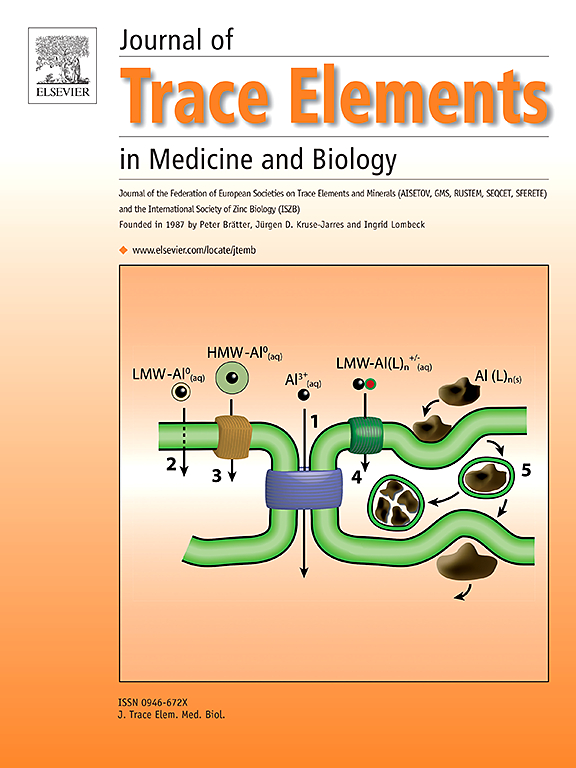Copper in human health: From COVID 19 to neurodegenerative diseases
IF 3.6
3区 医学
Q2 BIOCHEMISTRY & MOLECULAR BIOLOGY
Journal of Trace Elements in Medicine and Biology
Pub Date : 2025-03-28
DOI:10.1016/j.jtemb.2025.127636
引用次数: 0
Abstract
Copper (Cu) exists in two oxidation states Cu+I and Cu+II yielding formation of enzymes involved in biological processes. In higher concentrations, by oxidative process and ROS production, Cu is toxic towards plants, humans and animals livers as observed in Wilson disease or sheep scrapie. Fighting according to the Fenton reaction against bacteria and viruses, has been proposed as a mean of combatting nosocomial diseases and complementary to COVID19 vaccination. In humans, Cu is stocked in liver, muscle or bound to brain protein as ß-APP, tau-protein, α-synuclein, ubiquitin or prion which present antioxidant properties when Cu-bonded. In abnormal ß-sheet conformation, they can trigger neurodegenerative diseases such as Alzheimer(AD), Parkinson(PD) and ALS. In these diseases, blood copper increase correlated with brain copper decrease has been described. In AD, abnormal D-serine has been detected in blood and cerebrospinal fluid. D-glutamate and D-alanine blood levels have been found in AD and could also be controlled with Cu and ceruloplasmin in a possible disease screening test. This abnormal D-conformation might result from epimerization of physiologically L-conformation brain peptides into protease-resistant D-enantiomers. This has previously been experimentally demonstrated for Bovine Spongiform Encephalopathy in a free Cu reductive medium with UV-induced free radicals. The Cu brain protective effect against free radicals was restored with cupric addition in oxidizing medium. Cupric supplementation in the brain, might restore Cu protection and slow down neurodegenerative processes. To lower side effects, Cu amino-acid complexes able to cross the blood brain barrier might be suggested for a Cu transfer to the brain.
铜与人类健康:从COVID - 19到神经退行性疾病
铜(Cu)以Cu+I和Cu+II两种氧化态存在,生成酶参与生物过程。在较高浓度下,通过氧化过程和活性氧的产生,铜对植物、人类和动物的肝脏有毒,如在威尔逊病或羊痒病中观察到的那样。根据芬顿反应对抗细菌和病毒,已被提议作为对抗医院疾病的一种手段,并补充covid - 19疫苗接种。在人体中,铜储存在肝脏、肌肉中,或以ß-APP、tau蛋白、α-突触核蛋白、泛素或朊蛋白的形式与脑蛋白结合,当铜结合时,这些蛋白具有抗氧化特性。在异常的ß-sheet构象中,它们可以引发神经退行性疾病,如阿尔茨海默病(AD)、帕金森病(PD)和ALS。在这些疾病中,血铜增加与脑铜减少相关。在AD中,血液和脑脊液中检测到异常的d -丝氨酸。d -谷氨酸和d -丙氨酸的血水平已经在AD中被发现,并且在一种可能的疾病筛选试验中也可以用Cu和铜蓝蛋白来控制。这种异常的d -构象可能是由于生理上的l -构象脑肽向蛋白酶抗性d -对映体的外映。这已经在先前的实验中证明了牛海绵状脑病在自由Cu还原介质中与紫外线诱导的自由基。在氧化介质中添加铜,恢复铜对自由基的脑保护作用。在大脑中补充铜,可能恢复铜保护和减缓神经退行性过程。为了降低副作用,可能建议铜氨基酸复合物能够穿过血脑屏障将铜转移到大脑。
本文章由计算机程序翻译,如有差异,请以英文原文为准。
求助全文
约1分钟内获得全文
求助全文
来源期刊
CiteScore
6.60
自引率
2.90%
发文量
202
审稿时长
85 days
期刊介绍:
The journal provides the reader with a thorough description of theoretical and applied aspects of trace elements in medicine and biology and is devoted to the advancement of scientific knowledge about trace elements and trace element species. Trace elements play essential roles in the maintenance of physiological processes. During the last decades there has been a great deal of scientific investigation about the function and binding of trace elements. The Journal of Trace Elements in Medicine and Biology focuses on the description and dissemination of scientific results concerning the role of trace elements with respect to their mode of action in health and disease and nutritional importance. Progress in the knowledge of the biological role of trace elements depends, however, on advances in trace elements chemistry. Thus the Journal of Trace Elements in Medicine and Biology will include only those papers that base their results on proven analytical methods.
Also, we only publish those articles in which the quality assurance regarding the execution of experiments and achievement of results is guaranteed.

 求助内容:
求助内容: 应助结果提醒方式:
应助结果提醒方式:


